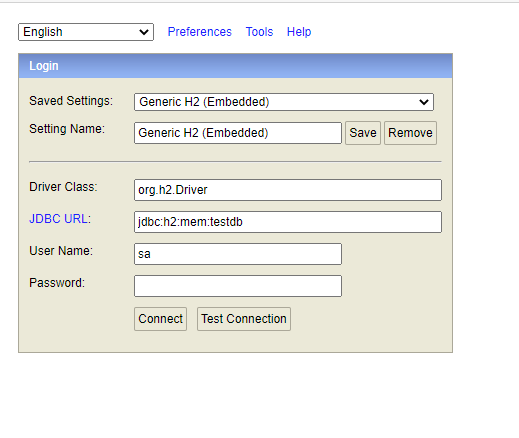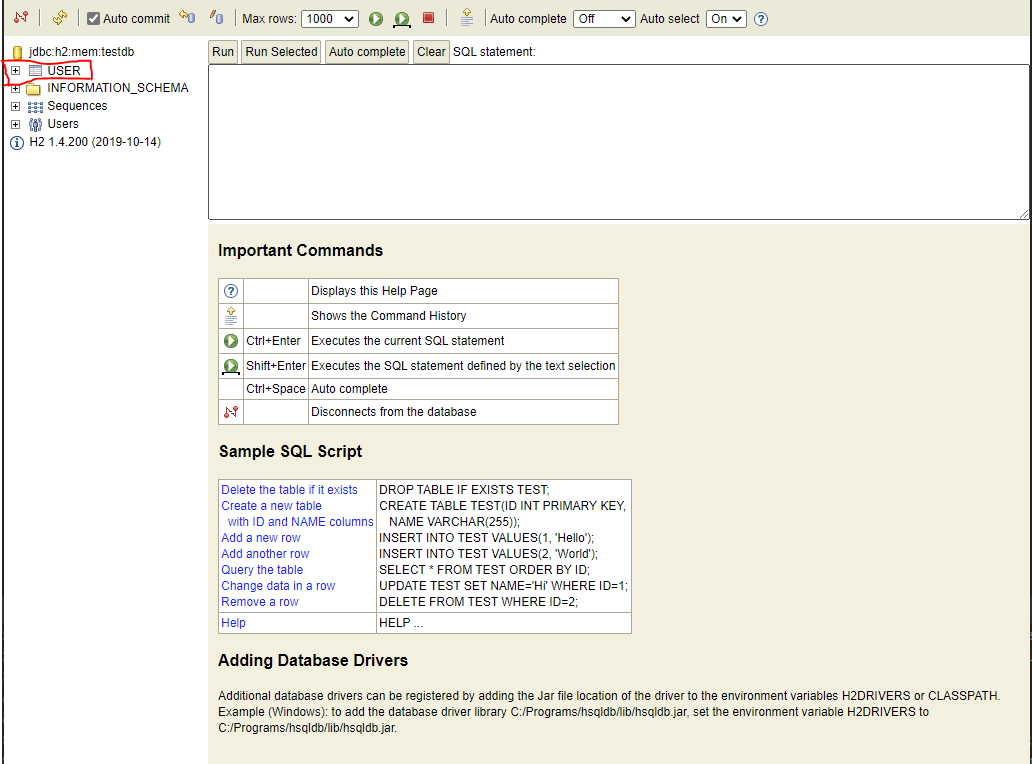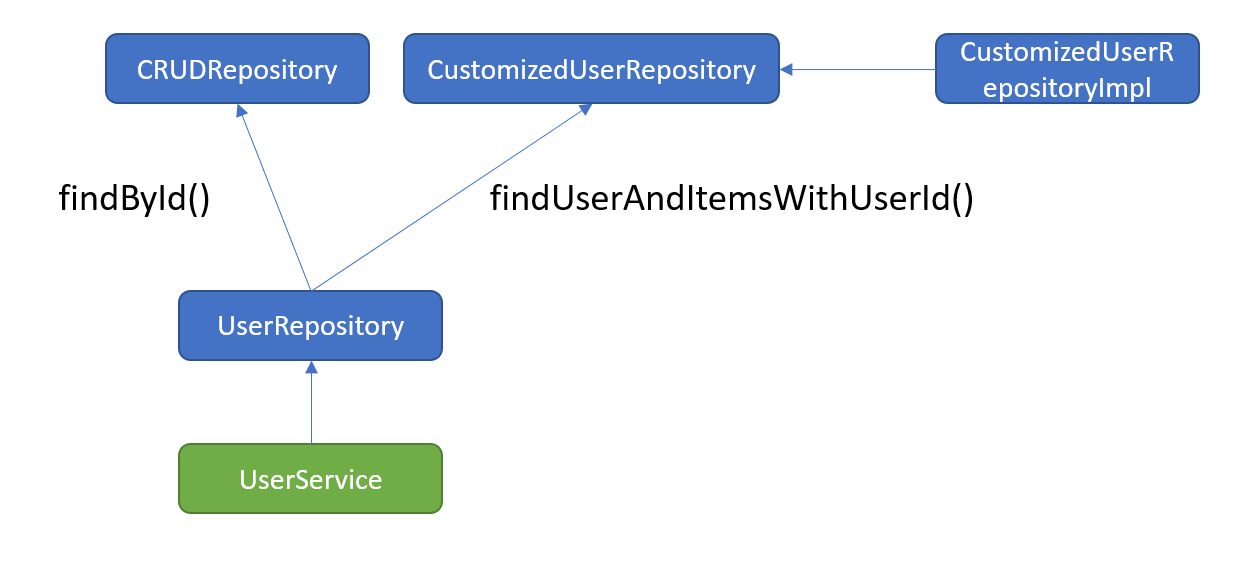Spring DATA JPA VS Spring JDBC Template
There are lot of ways to implement Spring DATA JPA, but I would say, when the Object design is simple: means not so many relations(is it or has it) between objects, then use Spring DATA JPA, if the Object design is complicatd: 3+ table composite into 1 object or the query is complicated, I would suggest use JDBC Template object which let you write SQL and handle the O/R mapping by yourself…it is not that difficult.
Source Code
https://github.com/R0NGSH3N/spring-restul-template
Entity Objects Setup
User Entity
@Entity
@Table(name = "user")
//@NamedQuery(name = "User.findByEmail", query = "Select u from user where u.email = ?1")
public class User {
@Id @GeneratedValue
Long Id;
@NotEmpty(message = "User Name can not be empty")
@Size(min = 4, max = 20, message = "user name has to be 4 - 20")
@Column(name = "name")
private String name;
@NotEmpty(message = "Password can not be empty")
@Size(min = 4, max = 20, message = "password has to be 4 - 20")
@Column(name = "password")
private String password;
@NotEmpty(message = "Email can not be emtpy")
@Email
@Column(name = "email")
private String email;
public List<Item> getItems() {
return items;
}
public void setItems(List<Item> items) {
this.items = items;
}
public void setId(Long id) {
Id = id;
}
public Long getId() {
return Id;
}
@ElementCollection
private List<Item> items;
public String getName() {
return name;
}
public void setName(String name) {
this.name = name;
}
public String getPassword() {
return password;
}
public void setPassword(String password) {
this.password = password;
}
public String getEmail() {
return email;
}
public void setEmail(String email) {
this.email = email;
}
}
Please notice the @ElementCollection annotation on items attribute, it represents the “1-to-N` relationship, so in the relation database, the table structure will be:
The User-Items table is the link table that present the relation between User and Item
Item Entity: User to Item is 1-to-n relationship
Let’s say we have shopping app, user can select many items and we will represent the relationship as 1 user to many items.
@Entity
@Table(name = "item")
@Embeddable
public class Item {
@Id
@GeneratedValue
Long Id;
@Column(name = "name")
private String name;
@Column(name = "price")
private BigDecimal unitPrice;
@Column(name = "provider")
private String provider;
public Long getId() {
return Id;
}
public void setId(Long id) {
Id = id;
}
public String getName() {
return name;
}
public void setName(String name) {
this.name = name;
}
public BigDecimal getUnitPrice() {
return unitPrice;
}
public void setUnitPrice(BigDecimal unitPrice) {
this.unitPrice = unitPrice;
}
public String getProvider() {
return provider;
}
public void setProvider(String provider) {
this.provider = provider;
}
}
Set up H2 testing Database
Since we are going to use database, the best test database with Spring is H2, following show how quick we can set up H2 database with Spring.
1.Add following in your resources folder:
spring.h2.console.enabled=true
spring.datasource.url=jdbc:h2:mem:testdb
spring.data.jpa.repositories.bootstrap-mode=default
2.Start the application, and go to http://localhost:8080/h2-console
you should see the screen as following:
3.Change the JDBC text into this
jdbc:h2:mem:testdb
4.You should see USER table in the testdb
Spring database Repository Design
In spring you can either use Spring Data JPA or Spring JDBC Template technology, I personal don’t think which one is better, it is really depends on use case, but from system design perspective, I would like to have just 1 repository that can include both technology. Here is our Repository design look like:
The UserRepository is the API face to Service, the CRUDRepository is the Spring Data JPA repository, the CustomizedUserRepository is using the JDBCTemplate
Using Spring DATA JPA
You need create Repository interface to implements the Spring Data JPA, 4 steps to create Repository:
1.Declare your repository interface (extends from Spring repository), usually we can extends from CRUDRepository, in the Spring repository, it will take care of Create and Update and Delete
2.Declare your Query in your repository interface
@Nullable
Stream<User> findByName(@Nullable String name);
that is all you need to do if you just want to query object by its attribute(s), here we create find method that can query user(s) by name. It return Stream object. Following the Service how to use this repository:
@Autowired
private UserRepository repository;
public List<User> getUserByName(String name){
try (Stream<User> stream = repository.findByName(name)) {
return stream.collect(Collectors.toList());
}
}
There are other methods that CRUDRepository provide, that you can just use them out of box, in the UserService there is another method find user by Id, it call findById method that directly on the CRUDRepository
@Autowired
private UserRepository repository;
public User getUserById(Long userId){
Optional<User> user = repository.findById(userId);
return user.orElseThrow(() -> new RuntimeException(userId + " user not found"));
}
we didn’t define the findById method in our UserRepository, it directly from CRUDRepository
3.Using @Repository Annotation to mark this is repository.
Using Spring JDBCTemplate
For complicate CRUD, you can use Customizing Individual Repositories to archive that purpose, in here, we will use JDBCTemplate to create customized Individual Repository.
3 steps to create this customized repository with JDBCTemplate and implementation
1.Create Repository Interface
public interface CustomizedUserRepository {
public User findUserAndItemsWithUserId(Long userId);
}
2.Create Implement Class of Customized Repository Interface
public class CustomizedUserRepositoryImpl implements CustomizedUserRepository{
private static final String SELECT_USER_WITH_ITEMS = "Select * FROM item WHERE id in (SELECT items_id FROM user_items WHERE user_id = ?)";
private static final String SELECT_USER = "Select * FROM user WHERE id = ?";
private JdbcTemplate jdbcTemplate;
@Autowired
public void setJdbcTemplate(JdbcTemplate jdbcTemplate) {
this.jdbcTemplate = jdbcTemplate;
}
@Override
public User findUserAndItemsWithUserId(Long userId) {
User linkedUser = jdbcTemplate.queryForObject(SELECT_USER, new Object[]{userId},
(rs,rowNum) ->{
User user = new User();
user.setId(rs.getLong("id"));
user.setName(rs.getString("name"));
user.setEmail(rs.getString("email"));
user.setPassword(rs.getString("password"));
return user;
});
List<Item> items = jdbcTemplate.query(SELECT_USER_WITH_ITEMS, new Object[]{userId},
(rs, rowNum) -> {
Item item = new Item();
item.setId(rs.getLong("id"));
item.setName(rs.getString("name"));
item.setProvider(rs.getString("provider"));
item.setUnitPrice(rs.getBigDecimal("price"));
return item;
} );
linkedUser.setItems(items);
return linkedUser;
}
}
in here, we define the findUserAndItemWithUserId method (both interface and implementation class), which is using jdbc template to complete the query.
3.Update your repository to extends from Customized Repository Interface
@Repository
public interface UserRepository extends CrudRepository<User, Long>, CustomizedUserRepository{
@Nullable
Stream<User> findByName(@Nullable String name);
Optional<User> findByEmail(String email);
}
In above UserRepository object, now it implements CrudRepository and CutomizedUserRepository interfaces.
As you can see, both findByXXX methods are from CRUDRepository, where is our JDBCTemplate method? the truth is you don’t need, since UserRepository extends CustomizedUserRepository interface, when service call findUserAndItemWithUserId method, the findUserAndItemWithUserId method in CustomizedUserRepositoryImpl will be called:
@Autowired
private UserRepository repository;
public User findUserWithItems(Long userId){
return repository.findUserAndItemsWithUserId(userId);
}
Conclusion
- Validation should leave to Model (User object in this case) object.
- There should be a center point to handle all the exception cross the board.
- The Response object should be an unified format.
- Controller Advice is solution for handle request/response cross the board, with this function, we can handle Exception and Response cross the board.



